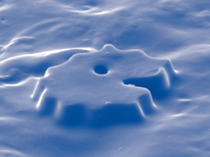Microscopic tags, half the thickness of a human hair, will make counterfeiters' lives much more difficult

The fake business is booming. Last year, consumers around the world purchased counterfeit products in the amount of approximately 500 billion dollars, according to the data of the International Coalition to Combat Counterfeiting. The counterfeiters counterfeit almost any product - from Viagra pills and cell phone batteries to designer clothes and baby food. However, it is possible that in the future the work of counterfeiters will be more difficult - thanks to the microscopic tags of Adhesives Research from Pennsylvania.
The tags are about 50 microns in diameter - about half the thickness of a human hair - and cannot be seen with the naked eye. Once the tag is attached to the product, it can only be located with the help of a mobile scanner - and this is only the first obstacle that counterfeiters must overcome. Unlike holograms, barcodes and identification tags are visible from other types, it is almost impossible to duplicate these tags. Each tag is specially designed for a particular company and can be made from dozens of materials. Tags for aircraft components can be made from heat-resistant plastic, tags from special polyester can be sewn into clothes, and edible cellulose tags can be sprayed on food products - in order to help the authorities locate the source of spoiled meat.
Adhesives Research produces the tags in a complex process of stamping. A special machine compresses the molten material through a mold to produce microscopic strips whose cross-section is unique to the particular product. The strips are then cut with knives, similar to slices of bread, into individual tags. When the manufacturer scans the tagged product with a reader, a digital image of the tag is obtained - and software compares the shape of the tag with the data stored in the file.
